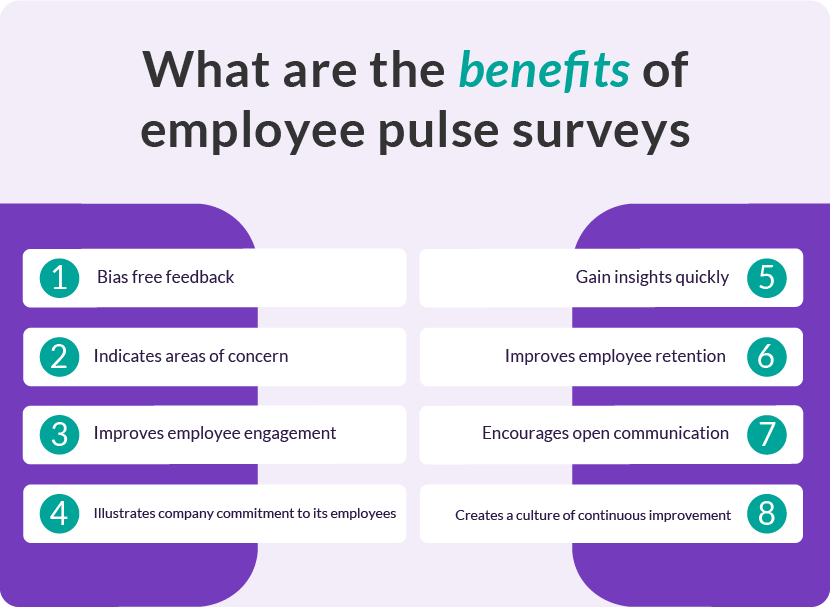Table of contents
Gathering and acting on feedback is crucial if you want to improve engagement, which drives greater business outcomes related to the employee experience, such as productivity and retention.
As 46% of organizations conduct engagement surveys only once a year and another 33% are running them every two years or less—companies may be missing out on the opportunity to engage staff with quick action. This is where pulse surveys come into the picture.
What are the benefits of employee pulse surveys?
Research shows that engagement is fluid, meaning that it changes frequently. By surveying just once a year or less, then taking months to act on the results, there may be a chance that the improvement strategies that organizations are using may be outdated.
Of course, there is not a one-size-fits-all solution to employee engagement surveys. Each organization must determine the best survey cadence for their employees, and create a customized approach based on the needs and capabilities of the organization.
Pulse surveys are specifically designed to gather timely and frequent feedback from employees on their work experience, such as their feelings about company culture, their teammates, role, and manager.
They’re integral to helping create a dynamic and proactive company culture that fosters continuous improvement, data-informed decision making, as well as employee engagement and retention.
Here are 8 top benefits of employee pulse surveys:
1. Illustrates company commitment to employees
Gathering data on employee sentiment shows that the organization is committed to its people, and they do this through frequent engagement, listening to feedback, and being transparent about the survey results.
However, failure to act promptly on feedback could lead to lower engagement levels. Unfortunately, inaction seems to be widespread, as highlighted by Gallup research that only 8% of people strongly agree that their company will take action on survey feedback. So organizations should implement a timely action plan after getting survey results back to demonstrate genuine commitment to employees.
2. Gain insights quickly
One of the key benefits to pulse surveys is their frequency, making it easier to gather immediate feedback for employers to identify issues and quickly act. They’re typically short and sweet, ranging from 5-15 questions, allowing for rapid and continuous compilation of up-to-date feedback.
Beyond greater participation, making surveys quick and easy for employees to complete has a myriad of benefits, including streamlined data collection and a quicker turnaround on data analysis, so organizations can respond to feedback promptly and efficiently.
3. Improves employee engagement
By checking in with employees regularly, it shows them that their feedback and opinions matter — ultimately boosting engagement. In fact, research exploring the link between pulse surveys and employee engagement reveals that 41% of people that were surveyed more than four times a year reported feeling very engaged.

While surveys alone aren’t enough to move the needle on engagement, organizations with “always on” feedback methods, such as continuous listening and check-in tools, are also responding quickly to feedback. These timely micro-actions demonstrate to employees that they are being listened to and that the company cares for their opinions.
The combination of listening to feedback and making timely improvements boosts commitment, advocacy, and enthusiasm—three of the key ingredients that make up employee engagement.
4. Improves employee retention
Pulse surveys can also help organizations improve employee retention rate, as the real-time insights help gauge job satisfaction and engagement levels. These surveys enable organizations to identify issues contributing to turnover, such as declining morale and low engagement, and be able to address them quickly.
Also, frequent surveys facilitate communication and foster a culture of trust and openness to feedback, which could lead to higher retention rates. As research indicates that 41% of employees are planning to search for a new role with an additional 24% feeling unsure, the insights gained from pulse surveys are more crucial than ever to employee retention.
5. Indicates areas of concern
Frequent check-ins via pulse surveys will also help organizations identify issues before they escalate. Some areas of concern that are important for employers to hone in on are: sentiments related to how effective they feel their manager is, how connected they feel to the company’s culture, mission, and values—as well as employee stress levels and ability to incorporate work-life balance.
An example of what pulse survey results could reveal is a decline in satisfaction with cross-team communication and the feeling that the work environment is becoming siloed. Leadership could follow-up on the issue by bringing in new communication channels and strategies in efforts to bridge the gap.
6. Encourages open communication
Pulse surveys are a way to gather feedback anonymously, granting the opportunity for employees to speak up without fear of judgement or retaliation. In fact, 77% of employees say they’re more likely to be honest when completing a survey instead of communicating directly with their manager.

The fact is that it’s sometimes difficult to be candid to someone’s face — especially if that person is potentially part of the problem. You’ll get much more honest and open responses from a survey than from your managers’ face-to-face meetings.
As pulse surveys are conducted on a regular basis, this establishes continuous dialogue between leadership and employees and fosters a culture of honest feedback. As research shows that 58% of surveyed leaders and individual contributors wished their organization conducted engagement surveys more often, leadership teams should prioritize regular check-ins with employees.
Pulse surveys maintain a flow of feedback in the workplace. However, introducing pulse surveys does require transparency and additional communication with employees, so they understand why a survey is taking place and how the results will be used.
7. Creates a culture of continuous improvement
Leadership can build a culture of continuous improvement with pulse surveys, as regular data collection allows management to make data-driven decisions on what should be improved. Over time, pulse surveys can also reveal key trends in employee engagement, job satisfaction, and organizational health.
According to Forbes, there are several elements that contribute to building a culture of continuous improvement. Those include regular feedback collection, embracing a democracy of ideas where everyone’s opinions are valued, and collaborative improvement — where teams across departments collectively address issues and come up with process enhancement strategies.
While a culture of continuous improvement isn’t built overnight, accessing frequent employee feedback through pulse surveys is a good place to start.
8. Bias-free feedback
For those unfamiliar with bias-free feedback, it’s in reference to feedback that isn’t influenced by any stereotypes, personal prejudices, or unrelated subjective opinions. Bias-free feedback is important as it’s more likely to be accurate, fair, and constructive—which makes identifying areas of improvement easier.
Pulse surveys can provide bias-free feedback for a number of reasons. They keep respondents anonymous, and by using survey questions with predefined response options — feedback stays focused on organizational issues instead of individual opinions.

Listening to employees benefits the whole organization
It’s important to make decisions based on the most up-to-date and accurate information. As our data shows, that means listening to employees frequently and acting on that feedback to increase engagement and drive business results.
Most employers are relying on annual surveys and manager conversations to gather that information, which we know is less effective than a listening tool such as pulse surveys or continuous conversation solutions.
If your organization wants to exceed employee expectations, drive better business results, and increase employee engagement, investigating pulse surveys should be your first stop. Start establishing a continuous listening approach at your organization today and reap the benefits of pulse surveys.


